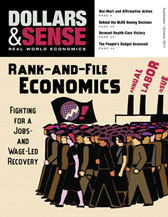This article is from Dollars & Sense: Real World Economics, available at http://www.dollarsandsense.org

This article is from the September/October 2011 issue of Dollars & Sense magazine.
Subscribe Now
at a 30% discount.
The People’s Budget
A Plan to Get Deficit-Reduction Off Our Backs
Balance the budget and have the federal government do more for those with less? Impossible, according to a Washington consensus convinced that a lethal dose of budget austerity was the only solution to the manufactured crisis over lifting the federal debt ceiling.
But why not? Because corporate elites, corporate-financed politicians of both parties, and a compliant corporate media ruled out the very measures that could do the job: Tax the rich and corporations as they had been taxed three decades ago, end the wars in Afghanistan and Iraq, expand Medicare to all, and devote the savings to renewing U.S. infrastructure and creating jobs.
Thankfully, one group of D.C. politicians escaped the groupthink: the Congressional Progressive Caucus, comprising one senator and 75 members of the House of Representatives dedicated to promoting a progressive agenda based on the promise of “fairness for all.” Last April the caucus released its budget proposal for fiscal year 2012. Dubbed the “People’s Budget,” the caucus’s plan would eliminate the federal budget deficit within a decade and would fulfill President Obama’s abandoned promise “not to balance the budget on the backs of the very people who have borne the biggest brunt of this recession.”
The People’s Budget increases the funding of Social Security, extends health-care reform, seriously reduces military spending, and institutes progressive tax reforms. In addition, it preserves Medicare, Medicaid, and Social Security benefits, and devotes its savings and additional revenues to boosting public investment as well as eliminating the budget deficit. Those measures would protect low-income people while asking those who have benefited most from the pro-rich economic growth of recent decades to contribute the most to closing the budget deficit. The chart on the next page provides a closer look at the plan.
In addition to cuts in wasteful spending and tax changes to raise additional revenue and create a more progressive tax system, the People’s Budget proposes $1.7 trillion worth of new spending on public investments over the coming decade. Specifically, it budgets $212.9 billion for a surface transportation reauthorization bill, including $30 billion as start-up costs for a national infrastructure bank that would leverage private financing to help rebuild America’s public capital stock. General public investments of $1.45 trillion, including high-speed rail and port improvement projects, are front-loaded to put Americans back to work quickly; $1.2 trillion of the total would be spent over the next five years.
Adding up these policy changes, the People’s Budget would reduce primary spending by $868.9 billion, reduce interest payments on government debt by $856 billion, increase general revenue by $2.8 trillion, and increase payroll tax receipts by $1.2 trillion over a decade, relative to the projections of the Congressional Budget Office based on current policy adjusted for two credible assumptions (that the Alternative Minimum Tax exemption will continue to be adjusted upward for inflation and that the “doc fix,” which prevents cuts in doctor reimbursements under Medicare, will continue, both of which add to the expected deficit).
In total, the People’s Budget would reduce deficits by $5.6 trillion over 2012-21 relative to this adjusted CBO baseline and is projected to turn the budget deficit to a budget surplus by the year 2021. At that point, the deficit would be 3.1% of GDP under the CBO baseline, and 4.0% of GDP under the adjusted CBO baseline. The House Republican Budget, aka the Ryan plan, and the president’s budget would also still be in the red in 2021.
We might prefer a budget proposal that did even more to tax the rich, made Medicare available to all, cut military spending by yet more, and expanded spending enough to close the jobs deficit even if it meant a larger federal budget deficit.
Still, the People’s Budget is a stunning proposal. It is far more progressive than any other budget proposal before Congress, insists on budget changes that respond to the actual drivers of the deficit over the next decade (the Bush Tax Cuts, the wars overseas, and the causes and effects of the economic crisis), and rekindles hope that yet more fundamental changes are possible.
For all those interested in avoiding “the fundamental moral default” that Jim Wallis of Sojourners, the progressive Christian organization, says will result “if low-income people are not exempted from deficit reduction,” the People’s Budget is our ticket to salvation.

Did you find this article useful? Please consider supporting our work by donating or subscribing.
